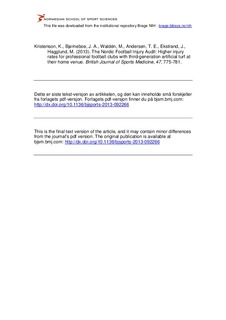| dc.contributor.author | Kristenson, Karolina | |
| dc.contributor.author | Bjørneboe, John | |
| dc.contributor.author | Waldén, Markus | |
| dc.contributor.author | Andersen, Thor Einar | |
| dc.contributor.author | Ekstrand, Jan | |
| dc.contributor.author | Hagglund, Martin | |
| dc.date.accessioned | 2014-03-06T13:39:13Z | |
| dc.date.available | 2014-03-06T13:39:13Z | |
| dc.date.issued | 2013-06-12 | |
| dc.identifier.citation | British Journal of Sports Medicine. 2103, 14, 775-781 | nb_NO |
| dc.identifier.uri | http://hdl.handle.net/11250/191293 | |
| dc.description | I Brage finner du siste tekst-versjon av artikkelen, og den kan inneholde ubetydelige forskjeller fra forlagets pdf-versjon. Forlagets pdf-versjon finner du på bjsm.bmj.com: http://dx.doi.org/10.1136/bjsports-2013-092266 / In Brage you'll find the final text version of the article, and it may contain insignificant differences from the journal's pdf version. The definitive version is available at bjsm.bmj.com: http://dx.doi.org/10.1136/bjsports-2013-092266 | nb_NO |
| dc.description.abstract | Background Previously, no difference in acute injury rate has been found when playing football on artificial turf (AT) compared with natural grass (NG).
Aim To compare acute injury rates in professional football played on AT and NG at the individual player level; and to compare, at club level, acute and overuse injury rates between clubs that have AT at their home venue (AT clubs) and clubs that have NG (NG clubs).
Methods 32 clubs (AT, n=11; NG, n=21) in the male Swedish and Norwegian premier leagues were followed prospectively during the 2010 and 2011 seasons. Injury rate was expressed as the number of time loss injuries/1000 h and compared with rate ratio (RR) and 99% CI.
Results No statistically significant differences were found in acute injury rates on AT compared with NG during match play (RR 0.98, 99% CI 0.79 to 1.22) or training (RR 1.14, 99% CI 0.86 to 1.50) when analysing at the individual player level. When analysing at the club level, however, AT clubs had a significantly higher acute training injury rate (RR 1.31, 99% CI 1.04 to 1.63) and overuse injury rate (RR 1.38, 99% CI 1.14 to 1.65) compared with NG clubs.
Conclusions At the individual player level, no significant differences were found in acute injury rates when playing on AT compared with NG. However, clubs with AT at their home venue had higher rates of acute training injuries and overuse injuries compared with clubs that played home matches on NG. | nb_NO |
| dc.language.iso | eng | nb_NO |
| dc.publisher | BMJ Publishing Group | nb_NO |
| dc.subject | VDP::Samfunnsvitenskap: 200::Samfunnsvitenskapelige idrettsfag: 330::Andre idrettsfag: 339 | nb_NO |
| dc.subject | adult | nb_NO |
| dc.subject | athletic injuries /epidemiology | nb_NO |
| dc.subject | floors and floorcoverings /statistics & numerical data | nb_NO |
| dc.subject | incidence | nb_NO |
| dc.subject | male | nb_NO |
| dc.subject | manufactured materials | nb_NO |
| dc.subject | Norway /epidemiology | nb_NO |
| dc.subject | poaceae | nb_NO |
| dc.subject | prospective studies | nb_NO |
| dc.subject | risk factors | nb_NO |
| dc.subject | soccer /injuries | nb_NO |
| dc.subject | Sweden /epidemiology | nb_NO |
| dc.subject | time factors | nb_NO |
| dc.title | The Nordic Football Injury Audit: Higher injury rates for professional football clubs with third-generation artificial turf at their home venue | nb_NO |
| dc.type | Journal article | nb_NO |
| dc.type | Peer reviewed | nb_NO |
| dc.source.journal | British Journal of Sports Medicine | nb_NO |
| dc.identifier.doi | 10.1136/bjsports-2013-092266 | |
| dc.description.localcode | Seksjon for idrettsmedisinske fag / Department of Sport Sciences | nb_NO |
